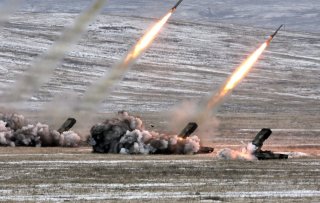Russia’s Killer Battlefield Weapon: The TOS-1 Buratino Rocket Launcher
TOS-1 groups can devastate enemy fortifications within a relatively large area in a short time span.
Here's What You Need to Remember: A $3 billion arms deal with the Saudi regime included “TOS-1A systems” along with S-400 anti-aircraft missiles, AGS-30 grenade launchers, Korney-EM anti-tank missiles and AK-130s, an export version of the AK-47 rifle. This comes as Saudi Arabia, which is heavily dependent on the United States and Western Europe, seeks a wider array of sources for weapons.
Lumbering with oversized, boxy turrets, TOS-1A Buratino thermobaric rocket launchers rolled out at the Shikhany training ground in southeast Russia in late October 2017. An array of tubes mounted on a T-72 tank chassis, the 45.3-ton Buratino is hardly a new weapon but one that has become increasingly popular internationally for its firepower.
Namely, two dozen 220-millimeter rockets — between 381 and 478 pounds depending on the version — equipped with either incendiary or thermobaric warheads. The latter creates an enormous explosion by emitting a flammable, chemical cloud that ignites the surrounding air with it.
A full salvo will devastate an area of 200 x 400 meters, killing by overpressure, burns, and suffocation.
At Shikhany, Russian army drones flew overhead, helping the rocket launchers hit their target — a simulated “illegal armed formation base,” according to the Russian Ministry of Defense.
The Buratino does not possess great range — up to 3,500 meters on the standard TOS-1 and 6,000 meters for the TOS-1A, an upgrade which has been in service since 2001. The TOS-1 entered use in 1988 when the Soviets were still at war in Afghanistan.
But the designers did not, apparently, see the short range as much of a drawback. Instead, they envisioned the TOS-1 as a support weapon to move with armored forces — hence the T-72 chassis — during breakthrough assaults on a European battlefield. Bunkers, fortified positions and built-up areas make logical targets for the Buratino.
If Soviet armored columns had met a position that was too tough for their tank cannons, the TOS-1 and its thermobaric rockets would do the job.
This is perhaps even more the case in the 21st century with its urbanized battlefields and proliferation of improvised explosives and deadly tank-killing weapons. Case in point is Syria, where Bashar Al Assad’s tank-heavy forces suffered horrific losses in built-up terrain versus rebels supplied with anti-tank missiles from the United States and their regional allies.
In Ukraine in 2015, at least one Buratino appeared with separatist fighters, according to the Organization for Security and Co-operation in Europe. The weapon could have only come from Russia.
However, the Buratino’s limited range may have presented a more recent liability. A 2016 video marked with the symbol of the short-lived Fatah Halab coalition of Syrian rebels in Aleppo showed what appeared to be a Syrian TOS-1A exploding in an enormous eruption — with rockets igniting and whizzing away — after an anti-tank missile strike.
Whether the video shows the destruction of one of the Syrian army’s actual Buratinos is unconfirmed, but the weapon’s design nevertheless requires them to get closer and take on a greater degree of risk than many kinds of heavy artillery.
Risk or no risk, the TOS-1A remains popular, if a niche weapon given the firepower. The Iraqi military rolled out Russian-made Buratinos in 2014 and used them again in the 2016-2017 offensive to free Mosul from Islamic State.
In 2016, the Azerbaijani army flung rockets from its TOS-1As at Armenian troops during one of the deadliest — if not the deadliest — outbreaks of violence since the Nagorno-Karabakh War of the early 1990s. Armenia also has TOS-1As, which is just one example of how Russia supplies weapons to both sides of that conflict.
Saudi Arabia could be the latest customer, according to a Russian government announcement from October 2017.
A $3 billion arms deal with the Saudi regime included “TOS-1A systems” along with S-400 anti-aircraft missiles, AGS-30 grenade launchers, Korney-EM anti-tank missiles and AK-130s, an export version of the AK-47 rifle. This comes as Saudi Arabia, which is heavily dependent on the United States and Western Europe, seeks a wider array of sources for weapons.
If Saudi Arabia so chooses, it could pick a new version of the TOS-1A’s rocket which Russia completed in 2016. The new rocket has a redesigned warhead and new solid-fuel propellant adding 4,000 meters of additional range, boosting the weapon to a maximum range of 10,000 meters.
Given the many threats facing such a short-range weapon, it’s easy to understand why Russia is placing a priority on adding some extra space between the Buratino and its targets. It’s a machine from the Cold War only now entering its prime.
Robert Beckhusen is Managing Editor of WarIsBoring.
This piece first appeared in 2017 and is being reprinted due to reader interest.
Image: Wikipedia.

